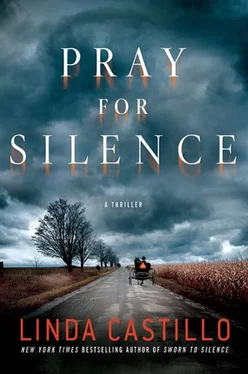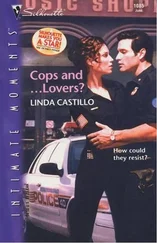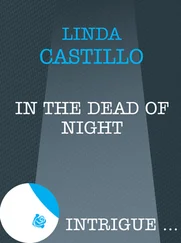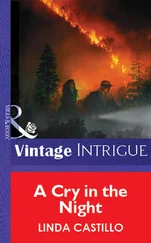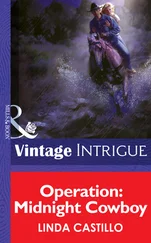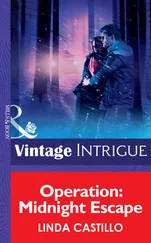“Going to take a minute or so,” he says. “I’ll continue with the exam.”
Setting his hands on the head of the corpse, he gently moves it from side to side. “Rigor has set in about the face and neck. Eyes are cloudy.”
“Any idea when you might get to the autopsies?” I’m thinking about the two girls in the barn. I want to know how they died. If they were sexually assaulted.
“I’ll juggle some appointments and begin immediately.”
I’m watching the doctor examine the dead man’s hands when a shadow on the corpse’s wrist snags my attention. Grabbing my Maglite, I train the beam on the wrist. I almost can’t believe my eyes. Just above the hand, a faint bruise encircles the wrist.
“Is that a bruise on his wrist?” I ask.
Doc Coblentz looks at me over the tops of his glasses, then his eyes follow the beam of my flashlight. His brows knit as he stares at the marks. “It certainly looks like it.”
Before even realizing I’m going to move, I reach for the corpse’s arm. I feel cold flesh through the thin latex of my glove. The stiffness of the joint associated with the early stages of rigor. In the stark light from my Maglite, I see clearly the circular pattern of the bruise.
“It’s the same bruising pattern we found on the boy’s wrists,” I say.
Something pings in my head, like a piece of puzzle I couldn’t make fit finally clicking into place. Realization trickles over me like ice water. Everything I thought I knew about this scene flies out the window. “He was bound,” I murmur.
The doctor is already looking at the other wrist. From where I kneel, I can see the bruising there, too. The doc shoots me a grim look. “I don’t believe we’re dealing with a suicide here, Kate.”
“The killer staged the scene,” I whisper.
“That appears to be the case.”
I think of the mother and baby lying dead in the yard, and a chill runs the length of my body hard enough to make me shudder. I think of the two girls in the barn, the evidence of torture, and all I can think is that there’s a cold-blooded killer running loose in my town. A monster with a bloodlust for killing and an appetite that has spiraled out of control.
CHAPTER 4
Before this morning, I haven’t smoked for nearly ten months. It’s a stupid, self-destructive habit. But as I watch Doc Coblentz examine the tortured body of a dead teenaged girl, I wish for a cigarette with the fervor of a heroin junkie craving a fix.
I’m standing in the tack room with Glock and Skid. No one’s talking. No one’s looking at the bodies. I wonder if I look as demoralized as my fellow officers do.
Officer Roland “Pickles” Shumaker arrived on the scene a few minutes ago. Wearing his trademark trench coat and pointy-toed cowboy boots, he looks like he’s just stepped off the set of some nuevo spaghetti western. He’s seventy-four years old, acts like he’s twenty-two, and doesn’t look a day over eighty. He moves a bit more slowly than the rest of my team, has lost a good bit of his eyesight and most of his hearing. But he has nearly fifty years of law enforcement experience under his belt. In my book, that alone makes him more valuable than some wet-behind-the-ears rookie who doesn’t know his ass from a hole in the ground.
“Looks like a goddamn massacre,” Pickles says, settling into his grumpy-old-man persona as he enters the tack room.
He’s right. The corpses are a macabre sight beneath the harsh glare of the work lights. This is the kind of scene that affects even the most hard-nosed of cops.
“We’re not dealing with a murder-suicide.” Looking from man to man, I tell them about the bruising on Amos Plank’s wrists. “This is murder, straight up.”
“Times seven,” Skid mutters.
Pickles looks around the room, grimacing. “So the son of bitch who butchered these girls is still out there.” It’s a statement, not a question.
I can tell by everyone’s expression that’s where they want to be, on the street, hunting the killer. But we all know the investigation starts here, with the evidence. “I briefed the sheriff’s office. They’ve stepped up patrols. T.J.’s been apprised; he’s out there, too.” I direct my attention to Glock, raising my voice to be heard above the drone of the generator. “Did you clear the outbuildings and silos?”
“Clear.”
I look at Skid. “Did you search the creek area behind the barn?”
He shakes his head. “No one there.”
“Tire tracks? Footprints?”
“If anyone was down there, he didn’t leave us squat.”
“We’ll go over every inch of this place again once the sun comes up. No one does this kind of crime without leaving something behind.”
Though the barn doors are open, the diesel exhaust from the generator is thick enough to choke a rhinoceros. No one’s complaining. I think I can speak for everyone in the room when I say the smell of exhaust is preferable to the stench of blood.
“As soon as we finish here,” I say, “we’ll start canvassing and talking to neighbors. Hopefully, someone saw something.”
“You going to call BCI?” asks Glock.
BCI is the Ohio Bureau of Criminal Apprehension and Identification out of Columbus, which is about a hundred miles west of here. It’s a state agency run by the attorney general’s office that offers a multitude of resources to local law enforcement, including a state-of-the-art lab, computer databases, crime scene technicians and field agents. The town council called the agency for assistance last year when a serial murderer stalked Painters Mill.
That’s how I met field agent John Tomasetti. He was instrumental in helping me close the Slaughterhouse Murders investigation ten months ago. The case was a nightmare, especially for me because of my personal connection to the killer. Tomasetti got me through it. He’s a good cop and an even better friend, and it’s him I think of this morning.
“I’m going to request a CSU to help process the scene.” I pull my cell phone from my pocket. “Maybe they’ll be able to pick up hair or fibers.”
The three cops nod in approval. But I know they’re feeling territorial about this case. The atrocities committed against this Amish family have angered and outraged them. While they appreciate any help, they don’t want some other agency encroaching on their turf.
“Chief Burkholder?”
I glance over to see Doc Coblentz standing next to one of the corpses. He looks grim and shaken, and I acknowledge that there is a small, selfish part of me that doesn’t want to go over there. Some crimes are simply too terrible for the eyes to behold, the mind to comprehend. But the part of me that is a cop knows information is my most powerful tool.
Dropping my cell back in my pocket, I force my legs to take me to him. “What do you have?”
For a moment the doctor stares down at the floor, his expression troubled. And I realize with some surprise this veteran man of medicine is so upset by what he’s seen that he can’t speak.
“I’ve never seen anything like it,” he says after a moment.
I’m aware of my team watching us from the doorway. It’s an uncomfortable moment. I’m not very good at offering comfort. I’m not even very good at receiving it. I give the doc a minute, and then I ask the question that’s been eating at me since I saw the bodies. “Do you know the cause of death?”
My question snaps him back. “I can’t be positive until I get them on the table, but I have a theory.” He glances toward Glock. “Have you photographed and documented everything?”
Glock gives a nod.
The doctor turns his attention back to me. “These two girls suffered long, horrific deaths, Katie. Look at this.”
We move closer to the nearest victim, Mary Plank. She’s about fifteen years old with the slender body of a girl on the brink of womanhood. Not yet an adult, not a child, but that special place in between. She probably still played like a kid. But her adult dreams were just forming in her head. She was pretty, with a kind face. It’s unbearably difficult to look at her and think of how she must have been. Sweet. Innocent. Undamaged by life. I can’t imagine the horrors these girls must have endured. I cannot fathom such brutality.
Читать дальше
